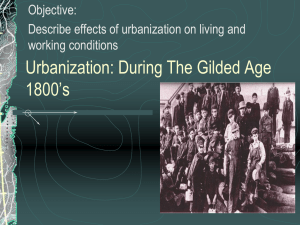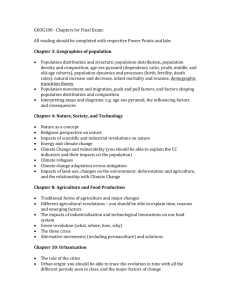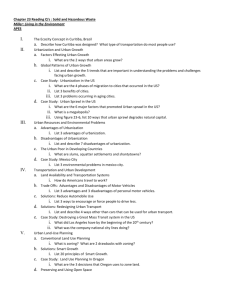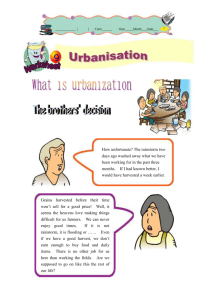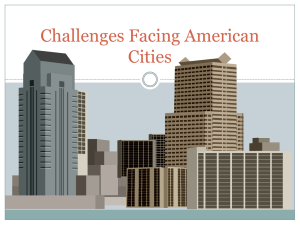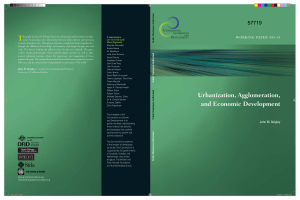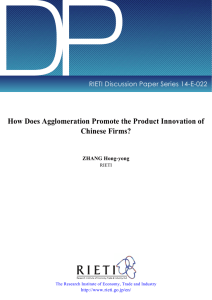ECON 3508 VI B. Urbanization - Introduction to Economic
advertisement
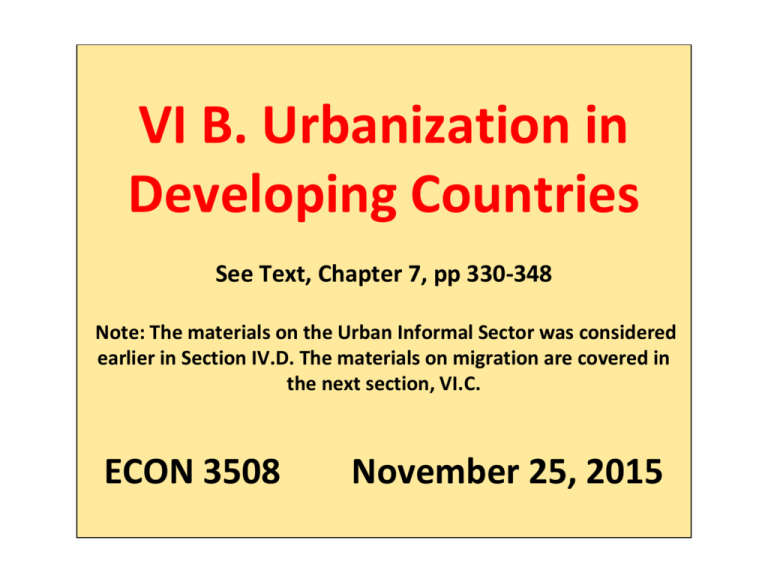
VI B. Urbanization in
Developing Countries
See Text, Chapter 7, pp 330-348
Note: The materials on the Urban Informal Sector was considered
earlier in Section IV.D. The materials on migration are covered in
the next section, VI.C.
ECON 3508
November 25, 2015
Agenda:
I.
Urbanization Trends and Patterns in
Developing Countries
II. The Role of Cities: Why do Cities Grow?
III. “Urban Giantism”
IV. Are There Alternatives to HyperUrbanization?
[Note: Material on the informal sector was covered earlier.
Migration will be covered in the next section]
I.
Urbanization Trends and Patterns in
Developing Countries
•
Rates of Urbanization
–
–
–
•
African Cities: rapid; often approaching or even
exceeding 6% per year;
Latin American Cities: decelerating; usually 1 - 2%
per year
Asian Cities: variable; 1 to 4% per year
Urbanization process:
–
approaching completion in a few countries where
rural populations are approaching or are less than
10% of total; e.g. Argentina, Chile, Uruguay,
Venezuela
–
will continue rapidly in countries which are still
largely rural, most especially in Africa
•
Megacities in Developing Countries: description
Figure 7.4 Megacities: Cities with Ten Million or More
Inhabitants
Figure 7.3 Proportion of Urban Population by Region, 1950-2050
Figure 7.2 Urbanization across Time and Income Levels
II. The Role of Cities: Why do Cities Grow?
Why do people move to and choose to live in cities?
“The economics of industrial location”
1. “Agglomerative economies “
(Providing cost advantages to producers)
•
Urbanization (general) economies,
–
–
•
•
Localization (industry or sector) economies
Infrastructure;
–
–
•
availability of necessary inputs, repair services, etc.
diversified range of all economic activities
Cost Saving on firm-to-firm, firm-to-consumer transportation
Railway, telecommunication etc. access
Skilled labour pools;
–
–
–
–
–
–
Proximity to government services and bureaucracy;
Presence of financial institutions, educational
institutions;
Technological funnel effect
Firms locating near workers with skills they need
Workers locating near firms that need their skills
Firms benefit from knowledge spillovers in their and
related industries and institutions (colleges &
universities)
2. Access to large local markets;
3. Consumers benefit from “urban amenities”
“Agglomeration Economies:” used in urban economics to
describe the benefits that firms obtain when locating near each
other ('agglomerating').
Include: - economies of scale
- network effects.
Simply put, as more firms in related industries cluster
together, costs of production may decline significantly
(competing multiple suppliers, greater specialization and
division of labor result).
Even when multiple firms in the same sector (competitors)
cluster, there may be advantages because that cluster attracts
more suppliers and customers than a single firm could alone.
Cities form and grow to exploit economies of agglomeration.
4. Note the normal hierarchical structure of
institutional structures and urbanization
patterns everywhere;
–
("Central Place Hierarchies")
5. Transportation System Structures: “Nodes”
(“hub and spoke” systems vis-a-visa “webs”)
6. The "clustering" phenomenon (to be elaborated
in class) (Michael Porter)
– "cumulative and circular causation”
• Quality of clusters, or Industrial Districts, is a key to
sectoral efficiency
• Unfortunately a majority of developing countries have
made only limited progress
Examples of Clusters:
China: Major advances in generating successful “clusters” over
the last decade: “Mega-clusters of ‘Clusters’ ”
III. “Urban Giantism” and "First city
dominance”
Why do these occur?
1. Colonial heritage in a few cases
2. Agglomerative economies:
3. Political centralization and concentration of government
roles in the capital city
4. “Urban bias” generally and "first city bias" specifically
in public policy of many sorts as well
5. Hub and spoke transportation system (rather than web)
makes transport costs high for small cities
6. Perhaps Import Substituting Industrialization: producing
for the home market behind protective barriers, leading to
location of economic activities near the domestic market
7. Autocracy and dictatorship?? Perhaps necessitating extreme
capital city bias (“bread and circuses” and benefits for first city)
Population of the Largest and Second-Largest Cities in Selected
Countries (millions)
Figure 7.7 Politics and Urban Concentration
Urban living quality:
–
–
–
huge variations
slums, housing, water, sewage, transport
environmental contamination,
Costs of Excessive Urban Concentration
–
–
–
•
Congestion costs
Higher infrastructure costs of a gargantuan
urban complex (transportation, sewage,
housing infrastructure generally)
social dysfunction??
Note:
–
–
Private Benefits for New Migrants to the cities;
Social Costs Generally for established Urban
Dwellers
In sum: Is Urbanization a “Good Thing”?
Why and or Why not?
IV. Are There Alternatives to Hyper- Urbanization?
Should there be?
Some Public Policies to reduce hyper-urbanization
patterns:
1. promote rural development and agriculture
with as much labour absorption or job
creation as possible
2.
decentralize government functions outside the
capital and major cities
3.
reduce all aspects of urban bias and “first city”
bias;
4. emphasize secondary and tertiary cities: get
urban growth out of the biggest cities
5. emphasize infrastructure in small cities,
towns regions and rural areas
6.
re-orientation of industrialization strategy:
from ISI to export promotion?
7. promote regional development outside the
central urban agglomerations


